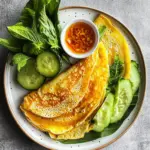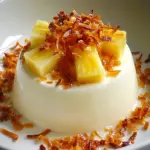The crispy Vietnamese spring roll, also known as Nem Rán or Chả Giò, is a beloved dish in Vietnamese cuisine. These spring rolls are made with a savory filling of ground pork, mushrooms, carrots, and glass noodles, all wrapped in delicate rice paper and fried to golden perfection. The crispy exterior contrasts beautifully with the tender and juicy filling, making them a favorite appetizer or snack.
Full Recipe:
Ingredients
-
1 pound ground pork
-
1 large carrot, grated
-
1 onion, finely chopped
-
2 ounces vermicelli noodles, soaked and chopped
-
1 ounce wood ear mushrooms, soaked and finely chopped
-
2 eggs
-
2 tablespoons fish sauce
-
1 teaspoon ground black pepper
-
1 package rice paper wrappers
-
Vegetable oil for frying
Directions
-
Prepare the Filling:
-
In a large mixing bowl, combine the ground pork, grated carrot, chopped onion, soaked and chopped vermicelli noodles, wood ear mushrooms, eggs, fish sauce, and black pepper. Mix well until thoroughly incorporated.
-
-
Wrap the Spring Rolls:
-
Fill a large bowl with warm water. Dip one rice paper wrapper into the water for about 5 seconds to soften. Lay it flat on a clean surface.
-
Place about 2 tablespoons of the filling near the center of the wrapper. Fold the sides over and roll tightly like a burrito to enclose the filling.
-
Repeat with the remaining wrappers and filling.
-
-
Fry the Rolls:
-
Heat about 1 inch of vegetable oil in a frying pan over medium-high heat.
-
Fry the spring rolls in batches, turning occasionally, for 5–7 minutes, or until golden brown and crispy.
-
Drain on paper towels to remove excess oil.
-
-
Serve:
-
Serve the spring rolls hot with a dipping sauce (nước chấm) and fresh herbs.
-
Nutrients
-
Calories: 290 kcal
-
Carbohydrates: 16g
-
Protein: 17g
-
Fat: 18g
-
Fiber: 2g
The Essential Components of Vietnamese Spring Rolls
The key to making authentic Vietnamese spring rolls lies in the balance of the filling, the rice paper wrapper, and the frying technique. The filling is made from a combination of ground pork, wood ear mushrooms, carrots, and vermicelli noodles, all seasoned with fish sauce and black pepper. This mixture is then wrapped in rice paper and deep-fried to perfection. The result is a golden, crunchy spring roll with a savory filling that offers a depth of flavor. Each ingredient in the filling serves a specific purpose: the pork adds richness and umami, the mushrooms offer earthiness, the carrots bring a slight sweetness, and the vermicelli noodles provide a delightful chewiness.
The rice paper wrappers are another important element of the spring roll. These delicate wrappers are made from rice flour and water and are used to encase the filling before the spring rolls are fried. The rice paper transforms into a crispy, golden crust when fried, providing the signature crunch that makes these spring rolls so irresistible. The combination of these elements creates a dish that is balanced in flavor and texture, with a satisfying crispiness on the outside and a juicy, tender filling inside.
A Dish with Cultural Significance
In Vietnam, crispy spring rolls are more than just a snack—they hold cultural significance and are often prepared for special occasions and family gatherings. They are a staple during the Lunar New Year (Tết), where they are often served alongside other traditional dishes as part of a festive feast. The process of making spring rolls is often a communal activity, with family members coming together to prepare the dish, share stories, and enjoy each other’s company. This makes Nem Rán or Chả Giò not just a delicious treat, but also a dish that represents the warmth of family and tradition.
The dish is also a popular choice in Vietnamese restaurants around the world, where it is served as an appetizer or a side dish to accompany larger meals. Its global popularity is a testament to its versatile and satisfying nature. Whether enjoyed in a fine dining setting or as street food, crispy Vietnamese spring rolls have become a beloved part of global cuisine.
Frying Technique: The Key to the Perfect Crispy Exterior
While the ingredients and seasoning of the spring roll filling are important, the frying technique is what truly makes the difference between a good spring roll and a great one. The oil must be heated to the right temperature—too hot, and the rolls will burn on the outside while remaining raw on the inside; too cold, and they will absorb excess oil, resulting in greasy spring rolls. Achieving the perfect crispiness requires careful attention to the temperature of the oil, as well as the timing during the frying process.
Typically, the spring rolls are fried in batches, turning occasionally to ensure that they cook evenly. The frying process takes around 5–7 minutes, depending on the heat and size of the rolls, and the result is a golden brown, crispy shell that contrasts beautifully with the soft, flavorful filling inside. Once fried, the rolls are placed on paper towels to drain any excess oil, ensuring that they stay light and crispy.
Dipping Sauce and Accompaniments
No Vietnamese spring roll is complete without its accompanying dipping sauce, known as nước chấm. This sauce is a combination of fish sauce, sugar, lime juice, garlic, and chili, creating a balanced flavor profile that is sweet, sour, salty, and spicy all at once. The sauce enhances the spring rolls and helps to cut through the richness of the fried exterior and the savory filling. Some variations of the sauce also include shredded carrots or sliced chilies for added flavor and heat.
In addition to the dipping sauce, fresh herbs such as cilantro, mint, and basil are often served alongside the spring rolls. These herbs add a refreshing contrast to the rich, crispy rolls and complement the dish’s savory filling. The herbs also add color and a burst of freshness, making the dish even more satisfying and aromatic. Some people also enjoy pairing their spring rolls with pickled vegetables or a light salad to add a bit of tanginess and crunch.
Customizing the Filling: Variations of the Classic Recipe
While the traditional filling for Vietnamese spring rolls contains ground pork, mushrooms, and vermicelli noodles, there are many variations that can be made to suit different tastes and dietary preferences. For example, ground chicken or beef can be substituted for the pork, or even tofu can be used for a vegetarian version of the dish. The mushrooms can also be replaced with other vegetables, such as shiitake or button mushrooms, or even bean sprouts for added crunch.
For those looking to experiment with flavor, additional seasonings such as ginger, lemongrass, or five-spice powder can be incorporated into the filling. These additions bring a unique twist to the classic dish while still preserving the essential characteristics of Vietnamese spring rolls. The beauty of this dish is its flexibility, as you can easily adjust the ingredients to suit your taste.
Making Vietnamese Spring Rolls at Home
Making Vietnamese spring rolls at home is a fun and rewarding experience, though it does require some practice to perfect the technique. The rice paper wrappers, which can be found in most Asian grocery stores, are relatively easy to work with once you get the hang of them. The key is to soften them just enough by dipping them in warm water, but not too long, or they will become too fragile and tear. After the filling is wrapped tightly in the rice paper, the rolls are ready to be fried.
While frying may seem intimidating at first, the process is quite simple. The most important thing is to ensure that the oil is heated properly and that the rolls are fried in batches to avoid overcrowding the pan. It’s also essential to monitor the rolls carefully to make sure they achieve the perfect golden-brown crispiness without burning.
Serving and Enjoying Vietnamese Spring Rolls
Crispy Vietnamese spring rolls are best served hot, fresh from the fryer, when they’re at their crispiest and juiciest. Serve them with a side of nước chấm dipping sauce, and garnish with fresh herbs for a complete and satisfying snack or appetizer. You can also enjoy them with a side of pickled vegetables or a light salad for extra crunch and acidity.
These spring rolls make a great addition to any meal or can be served on their own as a delicious snack. They’re perfect for gatherings, as they’re easy to eat with your hands and are sure to be a crowd-pleaser. Whether you’re serving them at a family dinner, a party, or enjoying them as a treat for yourself, crispy Vietnamese spring rolls are a dish that will never disappoint.
Conclusion
In conclusion, crispy Vietnamese spring rolls, or Nem Rán/Chả Giò, are a must-try dish for anyone who loves the bold, savory flavors of Vietnamese cuisine. With their golden, crispy exterior and tender, juicy filling, they offer a perfect balance of texture and taste. Whether you’re preparing them for a special occasion, a family meal, or a gathering with friends, these spring rolls are sure to impress. The versatility of the filling, the unique flavor profile, and the satisfying crunch of the fried rice paper make them a dish that can be enjoyed by all. Don’t forget to pair them with a tangy dipping sauce and fresh herbs to complete the experience. Whether enjoyed at home or at a restaurant, crispy Vietnamese spring rolls are a delightful culinary treat that captures the essence of Vietnamese cooking.






